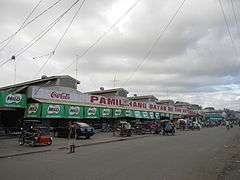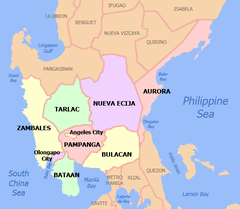San Antonio, Nueva Ecija
| San Antonio | |||
|---|---|---|---|
| Municipality | |||
| Municipality of San Antonio | |||
|
Welcome arch | |||
| |||
 Map of Nueva Ecija with San Antonio highlighted | |||
.svg.png) San Antonio Location within the Philippines | |||
| Coordinates: 15°23′N 120°48′E / 15.38°N 120.8°ECoordinates: 15°23′N 120°48′E / 15.38°N 120.8°E | |||
| Country |
| ||
| Region | Central Luzon (Region III) | ||
| Province | Nueva Ecija | ||
| District | 4th District | ||
| Barangays | 16 (see Barangays) | ||
| Government [1] | |||
| • Type | Sangguniang Bayan | ||
| • Mayor | Arvin Cruz Salonga | ||
| • Vice Mayor | Julie E. Maxwell | ||
| • Electorate | 51,113 voters (2016) | ||
| Area [2] | |||
| • Total | 153.56 km2 (59.29 sq mi) | ||
| Population (2015 census)[3] | |||
| • Total | 77,836 | ||
| • Density | 510/km2 (1,300/sq mi) | ||
| Time zone | UTC+8 (PST) | ||
| ZIP code | 3108 | ||
| PSGC | 034924000 | ||
| IDD : area code | +63 (0)44 | ||
| Climate type | Tropical monsoon climate | ||
| Income class | 1st municipal income class | ||
| Revenue (₱) | 157,416,515.57 (2016) | ||
| Native languages | Tagalog | ||
| Website |
www | ||
San Antonio, officially the Municipality of San Antonio, is a 1st class municipality in the province of Nueva Ecija, Philippines. According to the 2015 census, it has a population of 77,836 people.[3]
History
The present name of the town was given in 1843 in honor of the patron saint, San Antonio Abad, by Father Leocadio Luis, the first priest of the town. Before its organization and recognition as a town by means of a decree promulgated during the Spanish regime, this was a barangay of Gapan and was known as Barrio Delinquente.
San Antonio was previously called as the barrio of Delinquente as old residents claimed that the name Delinquente originated by the sinking of a Casco (big boat / banca ) fully loaded with palay in Pampanga River.
It was partitioned from the town of Gapan in 1843 by the order of Governor General Marcelino Oraa, along with the town of San Isidro. The movement of the separation of Barrio Delinquente from the town of Gapan, and its organization as an independent municipality. was ignited in 1839.The petition of the residents of Barrio Delinquente was finally approved in November 1842 but the definite separation from the town of Gapan took place in 1843.
It is bounded by the towns of Jaen to its eastern side, Zaragosa is to the north, Cabiao and San Isidro, and Concepcion in the Province of Tarlac is at its western border. From Manila the popular route going to San Antonio is via the North Luzon Expressway (NLEX), exiting at San Simon and head on to Jose Abad Santos Avenue turning right towards Arayat, Pampanga. Reaching the town of San Isidro, turn left to the road leading to San Antonio. The other route is to exit the NLEX at Santa Rita and traverse the Pan-Philippine Highway across the length of the Province of Bulacan up to Gapan City in Nueva ecija and turning left on the Gapan-Olongapo Road.
Local government
Municipal elected official (2016–present):
- Mayor
- Arvin Salonga
- Vice Mayore
- Julie Maxwell
- Councilors:
- Renan P. Morales
- Therese V. Javier
- Adonis Balagtas
- Polito Pamintuan
- Cris Cunanan
- Carel Galang
- Raniel Umali
- Maneng Balcos
Barangays
San Antonio is divided into 16 barangays.
- Buliran
- Cama Juan
- Julo
- Lawang Kupang
- Luyos
- Maugat
- Panabingan
- Papaya
- Poblacion
- San Francisco (KC1 or Kaisiwan)
- San José (Cabungan)
- San Mariano
- Santa Barbara
- Santa Cruz (Parang)
- Santo Cristo
- Tikiw
Demographics
| Population census of San Antonio | ||
|---|---|---|
| Year | Pop. | ±% p.a. |
| 1903 | 6,343 | — |
| 1918 | 10,395 | +3.35% |
| 1939 | 18,084 | +2.67% |
| 1948 | 16,518 | −1.00% |
| 1960 | 25,668 | +3.74% |
| 1970 | 33,862 | +2.81% |
| 1975 | 38,063 | +2.37% |
| 1980 | 42,969 | +2.45% |
| 1990 | 51,815 | +1.89% |
| 1995 | 56,130 | +1.51% |
| 2000 | 63,672 | +2.74% |
| 2007 | 67,446 | +0.80% |
| 2010 | 73,074 | +2.96% |
| Source: Philippine Statistics Authority[3][4][5][6] | ||
Economy
The people of San Antonio primarily depends on rice farming. The intercropping planting of vegetables, like ampalaya and beans, is common. In the past, watermelons and melons were part of the intercropping.
Tricycle operating and driving became a significant form of living, aside from those who are employed in the municipality, emergency hospitals, post office. health centers and the like. The town has also employed public school teachers in Central School and barangays.
Medium-sized entrepreneurs operate businesses as market stall owners and stores around the town and barangays are other source of living.
Available transports from the town to Manila are New RL Transport owned by the Lamsons and Five Star Bus Company. In the past, there were New E. Jose Trans. and Baliwag Transit, plying the same route.
There are few folks who engaged in fishing from nearby Along Along River or Chico River. There is a known tilapia raiser within the area of Palaisdaan ng Bayan.
Images
- Welcome arch
- Highway
- Town hall
- Facade of Saint Anthony Abbot Parish Church
 Public Market
Public Market
References
- ↑ "Municipality". Quezon City, Philippines: Department of the Interior and Local Government. Retrieved 31 May 2013.
- ↑ "Province: Nueva Ecija". PSGC Interactive. Quezon City, Philippines: Philippine Statistics Authority. Retrieved 12 November 2016.
- 1 2 3 Census of Population (2015). "Region III (Central Luzon)". Total Population by Province, City, Municipality and Barangay. PSA. Retrieved 20 June 2016.
- ↑ Census of Population and Housing (2010). "Region III (Central Luzon)". Total Population by Province, City, Municipality and Barangay. NSO. Retrieved 29 June 2016.
- ↑ Censuses of Population (1903–2007). "Region III (Central Luzon)". Table 1. Population Enumerated in Various Censuses by Province/Highly Urbanized City: 1903 to 2007. NSO.
- ↑ "Province of Nueva Ecija". Municipality Population Data. Local Water Utilities Administration Research Division. Retrieved 17 December 2016.
External links
| Wikimedia Commons has media related to San Antonio, Nueva Ecija. |


